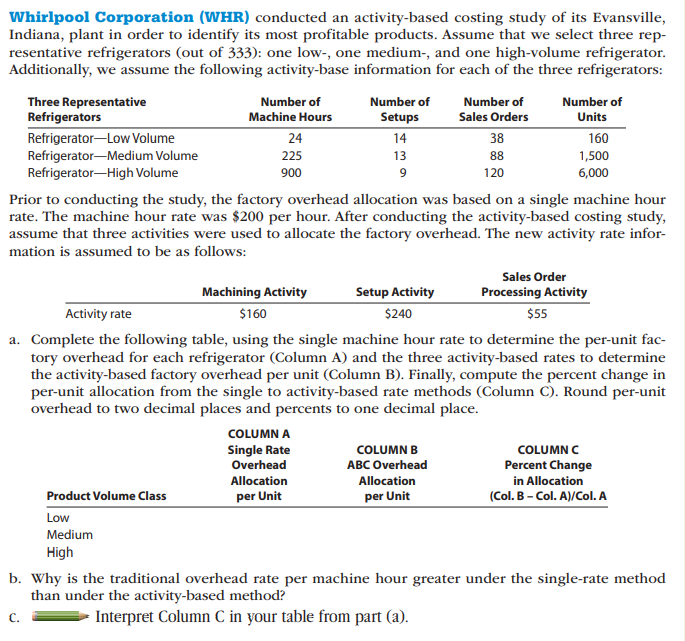Whirlpool Corporation (WHR) conducted an activity-based costing study of its Evansville, Indiana, plant in order to identify its most profitable products. Assume that we select three rep- resentative refrigerators (out of 333): one low-, one medium-, and one high-volume refrigerator. Additionally, we assume the following activity-base information for each of the three refrigerators: Number of Three Representative Refrigerators Number of Number of Number of Machine Hours Setups Sales Orders Units Refrigerator-Low Volume Refrigerator-Medium Volume Refrigerator-High Volume 24 14 38 160 225 13 88 1,500 900 9 120 6,000 Prior to conducting the study, the factory overhead allocation was based on a single machine hour rate. The machine hour rate was $200 per hour. After conducting the activity-based costing study, assume that three activities were used to allocate the factory overhead. The new activity rate infor- mation is assumed to be as follows: Sales Order Machining Activity Setup Activity Processing Activity Activity rate $160 $240 $5 a. Complete the following table, using the single machine hour rate to determine the per-unit fac- tory overhead for each refrigerator (Column A) and the three activity-based rates to determine the activity-based factory overhead per unit (Column B). Finally, compute the percent change in per-unit allocation from the single to activity-based rate methods (Column C). Round per-unit overhead to two decimal places and percents to one decimal place. COLUMN A Single Rate Overhead COLUMN B COLUMN C Percent Change in Allocation (Col. B - Col. A)/Col. A ABC Overhead Allocation Allocation Product Volume Class per Unit per Unit Low Medium High b. Why is the traditional overhead rate per machine hour greater under the single-rate method than under the activity-based method? C. Interpret Column C in your table from part (a).
Process Costing
Process costing is a sort of operation costing which is employed to determine the value of a product at each process or stage of producing process, applicable where goods produced from a series of continuous operations or procedure.
Job Costing
Job costing is adhesive costs of each and every job involved in the production processes. It is an accounting measure. It is a method which determines the cost of specific jobs, which are performed according to the consumer’s specifications. Job costing is possible only in businesses where the production is done as per the customer’s requirement. For example, some customers order to manufacture furniture as per their needs.
ABC Costing
Cost Accounting is a form of managerial accounting that helps the company in assessing the total variable cost so as to compute the cost of production. Cost accounting is generally used by the management so as to ensure better decision-making. In comparison to financial accounting, cost accounting has to follow a set standard ad can be used flexibly by the management as per their needs. The types of Cost Accounting include – Lean Accounting, Standard Costing, Marginal Costing and Activity Based Costing.

Trending now
This is a popular solution!
Step by step
Solved in 5 steps








